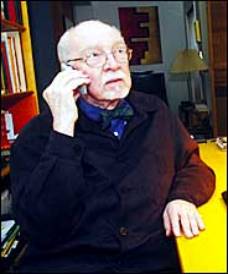|
|
In Pitch to Older Customers, Static for Cellphone Industry
By Matt Richtel, the New York Times
October 11, 2004

Thor Swift for The New York Times
Charles R. Temple, 77, a retired book publisher who still writes and who lives in San Francisco, says he uses his cellphone every day. Besides, he said, "It's good to have in case you faint, or stumble or get in trouble."
AARP, the powerful lobby and advocacy group for older Americans, is not happy with what it has heard from its members: complaints about incomprehensible service contracts, confusing bills and dead zones that are not clearly marked on coverage maps. They are the same concerns that have been expressed for years by other consumer advocates, who now have a new champion in the 35-million-member AARP.
We're hoping "to make the industry stand up and say, 'We've got to fix what's going on here,' '' said Susan Weinstock, national coordinator, economic and utility issues, with AARP. The group has already prompted the introduction of legislation in New York State that would provide more flexibility in canceling cellphone contracts, and it plans similar efforts in other states. AARP's campaign, which includes lobbying Congress, the Federal Communications Commission and state legislatures, and talk of running its own cellphone service, has caught the cellphone industry off guard and ill tempered. Consumer advocates say AARP's aggressiveness also reflects its own internal dynamics, that AARP is focusing on such a universally and easily agreed upon position to unite a membership angered and torn by the turmoil of last year's divisive Medicare fight. The cellphone industry has argued that it has done a good job of serving the needs of older customers and that what is best for people on fixed incomes is an industry free from taxation and regulation and thus, theoretically, able to offer lower prices.
Late in September, the two groups met for the first time to discuss common ground and their differences.
"For whatever reason, the AARP has been coming after us," said Steve Largent, president and chief executive of the Cellular Telecommunications and Internet Association. He is also a former congressman and a member of the National Football League Hall of Fame. "It is very troubling."
In the middle of the debate are people like Silvio Scocca, 77, a retired import-export broker in San Francisco.
Mr. Scocca and millions of other senior citizens are an alluring lot for the mobile phone industry, which has virtually tapped out the rest of the adult market. While about 80 percent of people 19 to 65 own mobile phones and more than 45 percent of those 10 to 18 do, only 39 percent of people 65 and older use them, according to the Yankee Group, a research firm. Moreover, older people who do use phones spend less money for fewer minutes each month than Americans under 65, the firm says.
"There are only so many 18-year-olds to market to," said Jeff Nelson, a spokesman for Verizon Wireless. "The senior population is a clear opportunity for growth."
But first marketers must overcome the concerns of Mr. Scocca and his peers, who say the phones are too small, too hard to hear and cost too much. Mr. Scocca ought to know. Two years ago, he bought service from AT&T Wireless. But he canceled it in May after the phone sat mostly unused on his kitchen table, though he spent $32 a month for service.
"It shouldn't be so perplexing to use," Mr. Scocca said, as he waited for lunch to be served at a Y.M.C.A. in San Francisco recently.
The feeling is not universal. Some customers, like Charles R. Temple, 77, said that they had adapted to the wireless era just fine. Mr. Temple, a retired book publisher who still writes and publishes newsletters in San Francisco, said he used his phone every day. Besides, he said, "It's good to have in case you faint, or stumble or get in trouble."
To create more converts, analysts said, the big phone makers are developing phones that will be easier to see and hear - and that will reverse the trend toward miniaturization.
If so, they would be mimicking efforts in Korea and Japan, where the higher penetration among older people has led to development of more elderly-friendly gadgets, said Peggy Johnson, a division president for Qualcomm, a company that makes software and computer chips used in cellphones worldwide.
|
|



